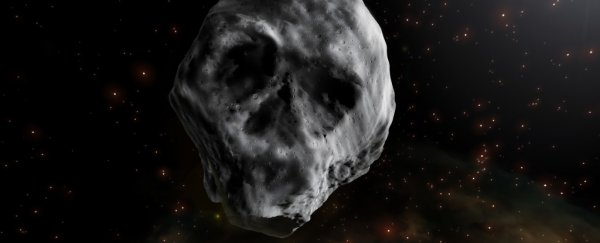A small Solar System object is about to pay us a second visit since its discovery in 2015. It's called 2015 TB145, also known as the Halloween Asteroid - and for good reason.
It's just perfect. It looks a little like a human skull in certain conditions; it's as dark as coal; its closest approach to Earth on its previous visit was on 31 October, 2015; and it's probably a dead comet.
You can't get a better concatenation of thematically related circumstances.
There are going to be a few differences with this year's visit though. The Halloween asteroid's first known flyby was really close - it buzzed by Earth just outside the Moon's orbit, at 486,000 kilometres (302,000 miles).
But it has a large orbital inclination, or highly tilted orbit, so when it swings by Earth, its distance from us varies. The 2015 flyby was the closest the asteroid will be to us for another 500 years.
It doesn't always visit on Halloween, either. Its orbital period is 1,112 days, or just over three years. So every time it visits, it's just a little later in our year than the last time.
This year's flyby is going to take place in early November, and the asteroid is going to be much farther away - around 105 times the distance between Earth and the Moon.
Nevertheless, it's a fascinating object, and - once they knew it was out there - researchers made an effort to study it in more detail.
Using a variety of telescopes, they were able to learn a lot about the asteroid during its 2015 approach, flyby, and departure.
"The object measures between 625 metres and 700 metres, its shape is a slightly flattened ellipsoid, and its rotation axis was roughly perpendicular to the Earth at the time of its closest proximity," said astrophysicist Pablo Santos-Sanz from the Institute of Astrophysics of Andalusia.
"Furthermore, its thermal inertia (the amount of heat which it retains and the speed at which it absorbs or transfers heat) is consistent with that of similar-sized asteroids."
The reason it was undiscovered until 2015 was partially because it spends most of its time out beyond Mars, and it's really small.
But also, as researchers discovered, really dark - its albedo, or the amount of light it reflects, was roughly equivalent to that of a lump of coal.
 (NAIC-Arecibo/NSF)
(NAIC-Arecibo/NSF)
Meanwhile the object's orbital eccentricity and tilt suggest that the asteroid was once a comet that has since lost all its volatile compounds after numerous orbits around the Sun, and is now a dead rock flying through space.
When the Halloween Asteroid returns this year, even though it will be much farther away, researchers are going to be taking the opportunity to learn even more about it - and, hopefully, by extension, other objects of similar mass that approach our planet.
If you want to know more, Santos-Sanz, Müller and their team published a paper about the asteroid last year in the journal Astronomy & Astrophysics.
It'd better still look like a skull when it comes around.
A version of this article was originally published in December 2017.
